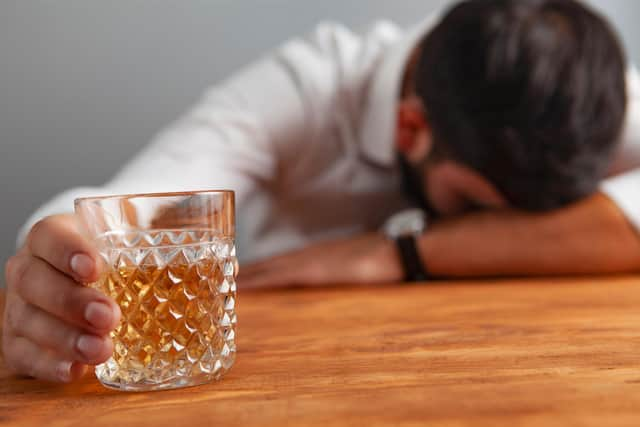Sober October: Is harmful drinking a uniquely Scottish problem, as alcohol deaths mount?
‘Dry January’ has a new rival – ‘Sober October’ – with thousands of Scots trying to give up drinking for a month. But how bad is Scotland’s relationship with alcohol? Is it really a historic part of Scottish culture?
The fact that giving up drinking for a month is considered a challenge for many people would suggest there are real problems with people’s relationship with alcohol – and the figures back this up.
Advertisement
Hide AdAdvertisement
Hide AdThe Scottish Government’s 2021 health survey found around one in four people (23 per cent) drink at hazardous or harmful levels, defined as drinking more than 14 units per week.


NHS Scotland defines ‘low risk’ drinking as anything below this level. However, the healthcare service warns it is called ‘low risk’ rather than ‘safe’ “because there's no safe drinking level”.
The type of illnesses you can develop after ten to 20 years of regularly drinking more than 14 units a week include mouth cancer, throat cancer and breast cancer; stroke; heart disease; liver disease; brain damage; and damage to the nervous system. According to NHS Scotland, there is also evidence that regular drinking at high-risk levels can make mental health worse.
“Research has found strong links between alcohol misuse and self-harming, including suicide,” the health service’s official guidance warns. “The effects of alcohol on your health will depend on how much you drink. The less you drink, the lower the health risks.”
With that in mind, one of the best measures of Scotland’s drinking problem is drink-related deaths.
The latest figures from the National Records of Scotland (NRS) show 1,276 people died from alcohol-specific causes, not including cancers caused by alcohol, last year. This is 31 more than in 2021, and the highest number since 2008.
Male deaths continue to account for around two thirds of alcohol-specific deaths. Female deaths increased by 31 to 440, with the number of alcohol-specific male deaths unchanged at 836.
The cost of alcohol is shouldered by the living, too. Although outdated now, the Scottish Government’s Societal Cost of Alcohol Misuse 2007 report, conducted by the University of York, estimated alcohol harm costs Scotland £3.6 billion a year in health, social care, crime, productive capacity and wider costs. Adjusted for inflation, that figure today would be £5.7bn.
Advertisement
Hide AdAdvertisement
Hide AdCompared to the rest of the UK, Scotland has a disproportionately high number of drink-related deaths.
“Scotland and Northern Ireland were the UK constituent countries with the highest alcohol-specific death rates in 2021, with 22.4 and 19.3 deaths per 100,000 persons, respectively,” reads a 2021 report from the UK’s Office for National Statistics.
“England and Wales continue to have lower rates of alcohol-specific deaths, with 13.9 and 15.0 deaths per 100,000 persons, respectively.”
It is easy to explain away the statistics as proof that alcoholism and alcohol-related deaths are a uniquely Scottish problem, that there is something innate in Scots that pushes them towards harmful drinking.
This misconception is not helped by the romantic mythologising of whisky and its contributions to Scottish culture and tourism, and its reputation on the global stage. Scottish whisky accounts for £6.2bn of Scotland’s exports.
But heavy drinking has not always been so heavily ingrained in daily life, and the statistics prove it.
From 1994 to 2006, Scotland’s annual alcohol deaths increased from less than 600 to more than 1,400. But then, from 2006 to 2012, there was a steady decrease to back under 1,000 deaths a year.
The historical trends of alcohol consumption in Scotland appear to be closely connected to affordability and poverty.
Advertisement
Hide AdAdvertisement
Hide AdDuring the 1980s and 1990s, alcohol became more readily available in supermarkets, which were able to offer alcohol at a fraction of the price of pubs and bars, where the intoxication of patrons is monitored by publicans as part of their alcohol licence.
Between the 1980s and the 2000s, consumption of alcohol in Scotland increased by about 50 per cent. Availability and cost might have been the carrot, but poverty has been the stick driving Scotland’s increased alcohol consumption and resultant deaths.
In June, a Public Health Scotland report found alcohol-related deaths in Scotland are five times more likely amongst the most deprived groups. The statistics evaluated by PHS included alcohol consumption, price, harms and inequalities.
It found "stark inequalities" between the poorest and most affluent adults who consume alcohol in terms of hospital stays and death statistics.
Furthermore, the Scottish Government estimates hospital admissions are eight times higher in the most deprived group..
Similarly, the disease burden of drug use disorders is 17 times higher in the most deprived areas compared with the least deprived, whilst 54 per cent of drug-related hospital admissions were patients living in the 20 per cent most deprived areas.
Since the 1980s, pay has fallen behind economic growth in the UK. A 2021 report from the London School of Economics showed that between 1981 and 2019, prior to the Covid-19 hit, productivity rose by 87 per cent, but median employee wages only rose by 62 per cent – a 25 percentage point “overall decoupling” between productivity growth and median wage growth.
Three-fifths of this gap is explained by the growth of inequality, which widened the wedge between mean and median employee wages. A further third is due to the increase in non-wage labour costs, in particular the growth of employer pension contributions.
Advertisement
Hide AdAdvertisement
Hide AdScotland’s industrial heritage has been gutted, while wage growth has stagnated. Now, inflation is running sky high amid an ongoing cost-of-living crisis.
Given the apparent correlation between inequality and drink deaths, it is therefore possible that any well meaning attempts to curb Scotland’s drinking will be hamstrung by the country’s economic outlook.
Comments
Want to join the conversation? Please or to comment on this article.